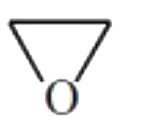The reaction of acetaldehyde with HCN followed by hydrolysis gives a product which exhibits
Optical isomerism
Geometrical isomerism
Metamerism
Tautomerism
The correct Answer is:A
To solve the question regarding the reaction of acetaldehyde with HCN followed by hydrolysis, we will follow these steps:
1. Identify the Reactants: The reactants are acetaldehyde (CH₃CHO) and hydrogen cyanide (HCN).
2. Reaction Mechanism: The reaction of acetaldehyde with HCN involves a nucleophilic addition. The cyanide ion (CN⁻) acts as a nucleophile and attacks the carbonyl carbon of acetaldehyde.
3. Formation of Cyanohydrin:
- The nucleophilic attack leads to the formation of a cyanohydrin. The structure of the cyanohydrin can be represented as:
CH₃−CH(OH)−CN
- Here, the hydroxyl group (OH) and the cyanide group (CN) are attached to the same carbon atom.
4. Hydrolysis of Cyanohydrin:
- When the cyanohydrin undergoes hydrolysis, it reacts with water to convert the cyanide group into a carboxylic acid group (COOH). The hydrolysis can be represented as:
CH₃−CH(OH)−CN+H₂O→CH₃−CH(OH)−COOH
- The product formed is lactic acid (2-hydroxypropanoic acid).
5. Identify Isomerism:
- The product, lactic acid, has a chiral center at the carbon atom bonded to the hydroxyl group (OH) and the carboxylic acid (COOH).
- This means lactic acid can exist in two enantiomeric forms (D and L forms), which are non-superimposable mirror images of each other.
6. Conclusion:
- Since lactic acid exhibits optical isomerism due to the presence of a chiral center, the final answer to the question is that the product exhibits optical isomerism.
Final Answer:
The product exhibits optical isomerism.
---
- The nucleophilic attack leads to the formation of a cyanohydrin. The structure of the cyanohydrin can be represented as:
CH₃−CH(OH)−CN
- Here, the hydroxyl group (OH) and the cyanide group (CN) are attached to the same carbon atom.
- When the cyanohydrin undergoes hydrolysis, it reacts with water to convert the cyanide group into a carboxylic acid group (COOH). The hydrolysis can be represented as:
CH₃−CH(OH)−CN+H₂O→CH₃−CH(OH)−COOH
- The product formed is lactic acid (2-hydroxypropanoic acid).
- The product, lactic acid, has a chiral center at the carbon atom bonded to the hydroxyl group (OH) and the carboxylic acid (COOH).
- This means lactic acid can exist in two enantiomeric forms (D and L forms), which are non-superimposable mirror images of each other.
- Since lactic acid exhibits optical isomerism due to the presence of a chiral center, the final answer to the question is that the product exhibits optical isomerism.
The product exhibits optical isomerism.
Topper's Solved these Questions
- BOOK - AAKASH INSTITUTE ENGLISHCHAPTER - ALDEHYDES, KETONES AND CARBOXYLIC ACIDS EXERCISE - Assignment (SECTION -B OBJECTIVE TYPES QUESTIONS (ONE OPTION IS CORRECT)24videos
ALDEHYDES, KETONES AND CARBOXYLIC ACIDS
- BOOK - AAKASH INSTITUTE ENGLISHCHAPTER - ALDEHYDES, KETONES AND CARBOXYLIC ACIDS EXERCISE - Assignment (SECTION -C Objective type questions more than one options are correct)11videos
ALDEHYDES, KETONES AND CARBOXYLIC ACIDS
- BOOK - AAKASH INSTITUTE ENGLISHCHAPTER - ALDEHYDES, KETONES AND CARBOXYLIC ACIDS EXERCISE - Illustrations3videos
ALDEHYDES, KETONES AND CARBOXYLIC ACIDS
- BOOK - AAKASH INSTITUTE ENGLISHCHAPTER - ALCOHOLS, PHENOLS AND ETHERS EXERCISE - Try Yourself5videos
ALCOHOLS, PHENOLS AND ETHERS
- BOOK - AAKASH INSTITUTE ENGLISHCHAPTER - AMINES EXERCISE - Assignment Section -J (Aakash Challengers Questions)9videos
AMINES
Similar Questions
Knowledge Check
- Question 1 - Select One
Cumene on reaction with oxygen followed by hydrolysis gives
ACH3OH and C6H5COCH3BC6H5OHand(CH3)2OCC6H5OCH3 and CH3OHDC6H5OH and CH3COCH3
The structure of Oxirane is
 The reaction of Oxirane with RMgX followed by hydrolysis will lead to product ? View Solution
The reaction of Oxirane with RMgX followed by hydrolysis will lead to product ? View SolutionReaction of propanal with HCN followed by acid hydrolysis of the reaction product with produce
View SolutionHow does acetaldehyde react with:
HCNView SolutionHow does acetaldehyde react with:
HCNView SolutionThe reaction of acetyl chloride with diethylcadmium followed by hydrolysis gives ……………..
View SolutionThe reaction of methyl magnesium iodide with acetone followed by hydrolysis gives secondary butanol.
View SolutionAcetoisonitrile on reaction with C2H5MgBr followed by hydrolysis, gives compound (A), which one further hydrolysis gives (B) and (C).
(B) and (C) are :View Solution
